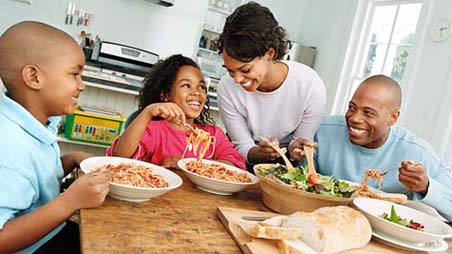Promoting Healthy Eating Habits

Many families are looking for ideas on how they can improve their family’s eating habits. But making changes that last takes time. Healthier habits are easier to make when changes are made together as a family. To kick-off this discussion, we’re giving you parents out there tips on creating healthier meal patterns. Pick one or two from the list below to help your family improve their eating habits.
Creating healthy meal patterns
- Define specific roles for the parents and child at meal times. The parent will choose what, when, and where foods are offered. The child will decide whether and how much they will eat.
- Provide meals and snacks on a regular schedule. Children should eat 3 meals and 2 to 3 snacks each day. Only offer water between meal and snack times.
- Serve snacks that are mini meals. Use foods from 2 or 3 food groups to create balanced snacks.
- Eat together as a family. Children will learn to make healthy choices by watching their parents. Encourage everyone to practice stopping when they are full.
- It can be easy to overeat if you are focused on something else. Avoid distractions while eating, especially screen time.
- Use nonfood items as rewards. Try activity related rewards, like playing a board-game with the family, one-on-one football with dad in the yard or dress-up with mom. Items like a book, ball, bracelet or stickers are healthy rewards, too.
- Some children eat because they are bored or dealing with emotions, like being sad or upset. Talk with your child about activities they can do when they are bored and how to cope with their feelings.
- Include your whole family in food preparation and cooking.
Prepared by: Christeena Johnson, RD
Adapted from: Seattle Children’s Hospital (2017). Healthy eating habits. Retrieved from:
https://www.seattlechildrens.org/globalassets/documents/for-patients-and-families/ce/CE220-healthy-eating-habits.pdf
Kid Chefs – 6 Tips to Getting Children Involved in the Kitchen & Eating Right | Chenell Griffiths

Kids in the Kitchen!
Getting kids involved in the kitchen is one great way in which parents can encourage their kids to eat right; let them be Kid Chefs! Kids that are involved in the meal preparation process feel encouraged to eat the meal they have helped to cooked.
However, do bear in mind that parents need to lead by example; and as such, in an effort to encourage children to eat right, parents must also eat right. Thus, meals that are prepared together (parents and their kids) should be had together. Without further ado, here are 6 tips for parents on how to get their kids involved in the kitchen, and eventually eating right:
6 Tips To Encourage Your Kid Chefs
- Ensure that you are never in a rush when cooking with children. Always be patient; you do not want them to associate meal preparation with the feeling of anxiety.
- Demonstrate kitchen safety measures and good hygiene practices. See Kitchen Safety Rules for Kids.
- Children ages 3-5 can help with
- mashing, mixing, stirring, blending,
- cracking eggs,
- using a butter knife to cut soft foods and
- washing ingredients.
In addition, children in this age group can also help with measuring and pouring. Measuring and pouring is a great time to incorporate practicing to count.
4. Children ages 6-12 can help with:
- cooking simple starches such as rice and pasta
- cutting and peeling vegetables
- separating eggs
- chopping, dicing and mincing of ingredients and also
- preparing easy breakfast items such as scrambles eggs, cereal with milk and oats porridge.
5. Have children help with age appropriate cleanup:
- children ages 3-5 can help by wiping up spills on the counter; likewise,
- children ages 6-12 can help with the washing of dishes and utensils and sweeping.
6. Finally, let your kid chefs know that they have done a good job, and thank them for helping you in the kitchen.
Though cooking with your children can get quite messy, above all, it is important to focus on the bonding experience as well as the fact that you are positively impacting their health, both physically and mentally, for the rest of their lives.
Written by Chenell Griffiths, Nutrition Educator
Learn MoreIs My Baby Growing Properly? | Kerry Weatherly

WEIGHT GAIN & GROWTH
The relationship between weight gain and growth begins at conception and continues through adolescence. From birth to the first year of life is a period of rapid weight gain and growth. The general guidelines for growth in the first year of life are:
Weight
- baby loses 5-10% of birth weight in the first week and regains this by 2-3 weeks
- birth weight is doubled by about 5 months and tripled by 12 months
Height / Length
- birth length increases 1.5 times in 12 months about 25.5 cm
Head Circumference
- birth head circumference increases by about 7.6 cm in 12 months.
It is important to remember these are guidelines. Weight gain and growth in infants will be individual. Clinicians track and assess growth using growth charts. These charts were developed based on standards which assume optimal conditions are present. Your infants growth and or weight may be above or below the standard. In many cases this is normal, and the overall trend is more important than a single recording. If you are concerned about a trend talking with a physician and a nutritionist who works with children may provide useful tips and practices to keep your baby on track. We strongly recommended that you keep a record of your infant’s growth and weight and update it regularly.
Important to note:
Exclusive breastfeeding means that baby gets ONLY breast milk only for the first six months of life.
This is recommended for an infant’s ideal growth and development.
COMPLEMENTARY FEEDING
At the age of six months complementary feeding should begin. Complementary foods are added with continued breast or formula feeding. Breast milk no longer provides all the nutrients needed for continued healthy growth and development after six months. Complementary feeding is necessary for adequate nutrition. One such nutrient required during this period of rapid growth is iron. Some good sources are fortified cereals, pureed meat, chicken, peas and beans. Vitamins C helps in the absorption of iron from plant sources. Vitamin C foods include pureed vegetables and fruit.
Complementary feeding, with the introduction of new textures and flavours is also important for taste development, acceptance of new foods and even speech.
Written by, Kerry Weatherly, Registered Dietitian/Nutritionist
Learn MoreLeading by example… “to the world”
Congrats to Miss Kitty! She has shown us that we can be our better self and our healthier self all at the same time. Childhood obesity is a serious issue throughout the Caribbean. It is creating problems for us now, and will continue to challenge the health and productivity sectors for years to come. Families fear starting on the path to “health”, but Miss Kitty has shown us all it is worth the effort.
Sure, she’s not running away from her fluffy ways, she’s as authentic as they come.
People aren’t abandoning her because she’s shedding her fluffiness.[…] she can use her new found shape to inspire more Jamaican women to understand that being ‘fluffy’ shouldn’t be your final comfortable state.
Thanks to Daily Veritas for highlighting the reality of obesity, starting in our children, while giving us a positive message of encouragement. Click on the link below to enjoy the entire article:
Is Miss Kitty still “fluffy to the world”? And why she’s perfect to change the nation…
Learn MoreDying to be Beautiful 2014
Please share this poster.
Please come: Be informed, get involved.
For more information click & go to the conference site.
Learn More
Obesity in Children: a growing problem

The Caribbean region is a curious mix of wealth and want, resources and deficiencies, and in no way is this better demonstrated by our curious blend of childhood malnutrition where both the critically undernourished and the disturbingly over-nourished child may live side by side on any street. We must pay attention to the sneaky but certain increase in obesity in our children as it will create increasing health challenges not only in childhood but in the later years, with sure increases in chronic non-communicable diseases.
The New York Times outlines findings from a recent study which show Obesity Is Found to Gain Its Hold in Earliest Years
Parents, teachers, governments of the West Indies, we MUST wake up and DO something now.
Learn MoreHunger and Behaviour
What would your answer be if someone asked, “What affects a child’s behaviour?”
- Genetics
- Socialization
- Faith & Religion
- Culture
Rarely would the answer include hunger. But believe it or not, hunger plays a major part in behaviour. Look at the most basic form of behaviour, newborn babies. How do you known when babies are hungry: their behaviour changes. Most definitely you won’t see a hungry baby laughing and playing. Likewise, the statement “a hungry man is an angry man” is factual.
Narrowing down to school-age children, hunger will affect them both academically, and socially. Teachers may report a child as lazy, disruptive, withdrawn/antisocial, or they may find the student is unable to grasp the simple concepts being taught in class. It is important to note that it isn’t absolute that this is simply a lazy child, a disruptive child, an antisocial child, or a child that isn’t smart. It could just be that the child is hungry. Yes: HUNGRY.
Hunger is not simply a craving. Hunger is a physiological condition that is brought about by the anticipation of a meal. Hunger may include a long-term painful experience brought on by lack of food over a prolonged period. Hunger can lead to starvation, stunted growth and development, and even death. Depending on the duration of hunger, the child’s behaviour may be change immediately by simply feeding them.
From as far back as 1998, Dr Murphy et al conducted and published research in the Journal of the American Academy of Child and Adolescent Psychiatry that revealed “Hungry and at-risk for hunger children were twice as likely as not-hungry children to be classified as having impaired functioning by parent and child report. Teachers reported higher levels of hyperactivity, absenteeism, and tardiness among hungry/at-risk children than not-hungry children.”

In addition, the Food Research and Action Center’s Breakfast for Learning report in 2010 reported that, “hungry children have lower math scores, are more likely to have to repeat a grade, are more likely to be hyperactive, absent or tardy, and have more behavioural and emotional problems in comparison to other children.”
Research coming out of Barbados, in conjunction with Harvard Medical School has recently confirmed that long-term changes occur in children who were hospitalized because of severe starvation. Although they had caught up with their physical growth, “these adults were more anxious, less sociable, less interested in new experiences and more hostile than those who were well-nourished throughout childhood”, as reported by Dr Janina Galler and her team in the Journal of Child Psychology and Psychiatry.
Now that you know that hunger affects your child’s behaviour, academically and socially, ensure that your child is properly fed. The best way of doing so is to ensure that they have the most important meal of the day:
BREAKFAST
Our Guest Blogger is Chenell Griffiths of Nutribites.
Check her out at nutribites.webs.com or follow her on twitter @NutriBites
Learn MoreBack to School: Eat smart! Nutritionist Kerry Weatherly speaks
Back to School: Eat Smart! Mrs Kerry Weatherly speaks on Smile Jamaica TVJ. There is no “bad” food or “good” food. Listen in and learn some tips on the right WAY to feed your school-age children.
BREAKFAST: hot or cold cereal with milk and a fresh fruit make a quick, nutritious and affordable breakfast
LUNCH: send your child to school with a fresh fruit even if they are getting lunch at school.
Even on a budget, you can serve the SAME FOODS prepared in different ways, and keep food interesting! Choosy kids enjoy being given the opportunity to be a part of the decision making. Get them involved!
Enjoy the video 🙂 and please share your comments with us.
Learn More
Portion-Sized not Super-Sized
![]() 12-year-old Marshall Reid has taken matters into his own hands and is motivating his family to eat right and exercise. Please enjoy this engaging account of how a child can show the way for so many others.
12-year-old Marshall Reid has taken matters into his own hands and is motivating his family to eat right and exercise. Please enjoy this engaging account of how a child can show the way for so many others.

In theory, losing weight should be straightforward: eat healthier, subtract quantity, add exercise. In the real world, though, where each family member can have a different relationship with food, that equation can be far more complicated.
A Child Offers Plan on Portion Control for Dieters – NYTimes.com.
How can we empower children in the Caribbean to eat healthy and slow the alarming rates of high-blood pressure and diabetes that is literally killing our nations?
Learn MoreNew research shows black American children at HIGHEST risk of being overweight
In particular, children and teens who currently have higher obesity rates would require larger energy gap reductions [more dietary restriction and more exercise] to reach the obesity rate goal. For instance, based on their current obesity rates, white youths would need a 46-calorie reduction, on average, in their energy gap to reach the goals. But given their higher obesity rates in 2008-2010, the average reduction needed to close the energy gap for Mexican-American youths is 91 calories and, for black youths, it is 138 calories. Youths in lower-income communities also need greater reductions than their peers in higher-income areas, again due to higher rates of obesity. Additionally, an earlier study by several of the same researchers found that the problem is especially acute for teens who are already overweight.
The solutions are the same: it take time more than money, to make lifestyle changes.
Learn MoreThe authors outline several policy strategies that could help to close the daily energy gap for American youths. For instance, they point to research showing that:
- replacing all sugar-sweetened beverages in school with water and not consuming any additional sugary beverages outside of school could reduce the energy gap by 12 calories per day;
- participating in a comprehensive physical education program could eliminate 19 calories per day among children ages 9-11; and
- engaging in an after-school activity program for children in grades K-5 results in an additional 25 calories expended per day.









